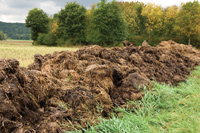
Manure nutrients, while they come
in a less than desirable formulation, are valuable to feed crops and
build soil organic matter. Careful management of animal manure is
important to optimize the return from field application.
 |
| Unlike commercial fertilizer, which has a guaranteed analysis, manure nutrients tend to be highly variable based on the source, feeding management, collection, and storage practices used. This variability means that manure analysis is essential for effective nutrient application practices. |
 |
Manure nutrients, while they come in a less than desirable formulation, are valuable to feed crops and build soil organic matter. Careful management of animal manure is important to optimize the return from field application. Improper use of manure can result in over-application of nutrients, a major growing concern to the sustainability of agriculture lands.
Do you know how much land receives manure? The 2001 Census of Agriculture in Canada asked farmers how many acres they applied manure to and the results were surprising. Manitoba was the highest in Western Canada with 4.5 per cent of all crop, fallow, and hay lands receiving manure. This was followed by 3.9 per cent in Alberta and 1.3 per cent in Saskatchewan. These are very small acreages when you consider that fertilizer is applied to 56 to 70 per cent of the same area.
Manure contains a number of essential plant nutrients. Nitrogen, phosphorus, and potassium are all part of manure additions, along with a wide variety of secondary and micronutrients. Unlike commercial fertilizer, which has a guaranteed analysis, manure nutrients tend to be highly variable based on the source, feeding management, collection, and storage practices used. This variability means that manure analysis is essential for effective nutrient application practices.
 |
| Dr. Adrian M. Johnston is the Western Canada director of the Potash and Phosphate Institute. He can be reached at ajohnston@ppi-ppic.org. |
Manure nitrogen is sometimes hard to estimate relative to fertilizer nitrogen. Almost half of the nitrogen in fresh manure is in the ammonium form, readily available to plants if properly managed. In the case of swine manure the plant-available nitrogen can be much higher. The remaining, or organic nitrogen, is released based on microbial processes with the help of warm soil temperatures and water. This provides a release of nitrogen over several years, a benefit which can be significant with manure that contains lots of straw. Remember that ammonia can be lost from manure when ammonium is converted to ammonia. Incorporation or injection into the soil is critical to capturing this nitrogen.
Phosphorus and potassium availability varies from 50 to 100 per cent in the application year. There are few environmental concerns associated with excessive potassium in soils, but that is not the case for phosphorus. Be aware that manure runoff and loss from fields, as well as treated soil, can pollute surface waters when high in phosphorus. Every attempt should be made to minimize this loss, an important responsibility for land managers.
Nutrients are not the only value to manure. While many farmers are now focusing on improving the use of manure to avoid high fertilizer costs, manure also helps improve soil organic matter, soil physical structure, and water holding capacity. It is important to remember that applying manure to land for the first time actually provides some of the best responses recorded, something that may help when calculating the cost of hauling manure.
Manure application is going to become closely scrutinized – it is time to ensure you are ready for an environmental audit. While manure will not replace commercial fertilizer, there are many more acres that would benefit from its application. As a crop adviser, if you work with manure managers, be sure and help them avoid any problems that may come with proposed soil phosphorus regulations. Good management is needed to capture the full value of the product.
Print this page